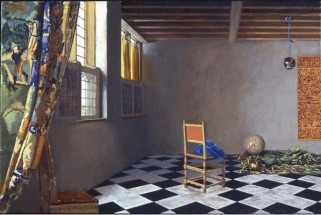|
|
|
| Work
An Allegory of Faith
| Date: | 2002
|
| Medium: | Oil on canvas |
| Size inches: | 46 x 72 |
| Size cm: | 116.8 x 182.9
|
| Signature: | Signed and dated lower right and inscribed on the reverse |
| |
| Location: | GUC Collection, Chicago |
(George Deem) paints versions of Vermeer, but not in the usual, and by now superficial, postmodern sense of "quoting" or "appropriating" the Dutch master. Rather, he skillfully executes a Vermeer, but without the people present in those lush, redolent interiors, as in "An Allegory of Faith," 2002.... In a sense he is creating what I would call a temporal collage. Where the founders of cubism used commercially manufactured wallpaper in newly spatialized combinations with other graphic material to open up the semantic code of the represented image, Deem uses our memory of the "true" Vermeer as a present absence to qualify what we are seeing. But as with the well known use of modernist collage, the irony cuts both ways. We "see" a Vermeer that is not there, and we see a Vermeer-like effect that is altogether there. Deem's great technical skill -- which he himself mocks or self-criticizes by painting in test patches or uneven, roughly executed borders -- allows for something like a negative dialectic.... In what we can call "temporal collage" (as opposed to the spatial variety), we see two differently temporalized images. The historical context of one image, or its partial representation, is being juxtaposed against another historical moment, or against the "now" of the painting.... In the "now" of the painting that uses temporal collage we experience a framework that appears folded against itself, or is like two facing mirrors. The original Vermeer, or rather our memory of it, is what gives the Deem work its temporal definition as an echo or recovered memory, even as it reasserts the historicity of the Vermeer, which our recollection has presented to us less as an historical object than as a memory that is both willfully invoked and involuntary.
(Charles Molesworth, "How To Live in an Image World: The Strategies of Memory," Salmagundi, Summer-Fall, Skidmore College, Saratoga Springs, New York, 2003)
| Image Notes
Reference
Allegory of Faith, c. 1671-74, The Metropolitan Museum of Art, New York.
The windows are from The Music Lesson, c. 1662-64, The Royal Collection, London.
The chair behind the tapestry is from The Art of Painting, c. 1666-67, Kunsthistorisches Museum, Vienna.
George Deem's (paintings after Vermeer) invite the postmodern eye to a pictorial disquisition concerning originality and perspective ... He includes re-creations, transpositions and alterations of his models, eliminating the figures that animate the originals as well as eradicating much of the iconography that informs art-historical speculation concerning Vermeer's intentions.
Retaining the theatrical device of the draped carpet from Vermeer's Allegory of the Faith, Deem extends his interpretation of that painting horizontally, adding enough space to ... (his painting) An Allegory of Faith to greatly exaggerate the perspectival effect of Vermeer's study in checkered tile. As though in the process of distilling all Vermeer to the single room of the master's studio, Deem introduces a wall of windows formerly concealed by drapes. In Deem's painting, the swooning, theatrical model for Faith has vanished, and her bosom and sandals with her. Vermeer's representation of Jordaen's painting of the crucifixion has vanished from the rear wall, and the chalice, crucifix, devotional book, Eve's apple, and the stomped serpent of the original are also gone. Remaining are the brocade tapestry, the glass sphere floating at the end of its ribbon, the luminous globe, the carefully rendered carpeting as drape and throw.
By any accounting, the painting has by now been divested of the greater part of its inventory of emblems, as though stripped down to be cast and costumed for another subject, and in the process, arguably, invested with meanings of another sort. At the upper margin of his painting after Vermeer's original, Deem refers to the business of painting ... and a cloudlike, mottled burst of paint erupts from the topmost extremity of the picture plane ... This not altogether irreverent conceit suggests Deem's discovery of a closeted bravura that beats within the ostensibly pellucid heart of Jan Vermeer.
(Edward Leffingwell, "George Deem at Pavel Zoubok." illus. Art in America, New York, July 2003.
| Artist's Notes
Today is Monday March 18 and I have completed "An Allegory of Faith." (Notebook entry, 2002)
| Exhibitions
Pavel Zoubok Gallery, New York
|


